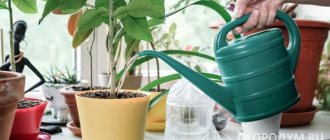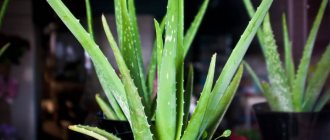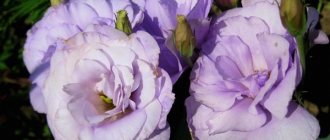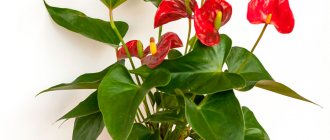Eustoma is a flower that looks like a rose, with delicate poppy petals. Maybe that's why it's called the Irish rose. The official name is lisianthus. The plant is an annual plant and reproduces only by seeds. It is grown infrequently in private plots, but in vain. Not everyone succeeds in growing full-fledged seedlings the first time, probably because few people know what conditions a flower needs for full development, and how to feed eustoma seedlings at home.
Eustoma is an Irish rose. Difficulties in growing.
Eustoma is considered a rather whimsical plant in the first three months of growth, but if the gardener still manages to grow it, then there will be no limit to delight. When Eustoma blooms, the bush is completely covered with buds and flowers. In addition, the flowering time lasts a very long time, and cut flowers can last up to 2-3 weeks in a vase.
This southern plant requires a fairly large amount of light and heat. Therefore, when grown from autumn to spring, they need additional illumination with phytolamps for up to 16 hours a day, but in the summer it is better to use them. The temperature when growing Eustoma must be maintained at 20-25°C. At higher temperatures, it may not bloom in the first year. Low temperatures and lack of light also have a bad effect on flower budding.
Types and varieties
Perennial eustoma can come in a wide variety of shades. So you can enjoy purple, yellow, snow-white, pink, blue, coral, and bicolor flowers.
- Annual specimens do not require care and reproduce without much difficulty. Even the most inexperienced amateur gardener can grow them.
- If you decide to grow a perennial type of Irish rose, then you need to work hard. If you do everything right, you can enjoy longer and more luxuriant flowering. It is often grown in pots on windowsills or in greenhouse conditions.
- The indoor variety is low-growing flowers, not exceeding 30 cm in height. As a rule, they grow well in well-lit rooms.
Irish rose varieties
Large-flowered Russell's lisanthus
It is considered the most beautiful and spectacular species. Found in Central America. It is characterized by a straight stem on which there are rather large flowers attached to long peduncles. The variety is similar to poppy.
Eustoma cutting Mage mixture
- Maje Deep Rose with delicate pink inflorescences similar to small roses
- Blue Rome with exquisite blue flowers
- Maj Red with catchy red-scarlet large peduncles soaring above the green foliage
- Maj Yellow boasts bright golden-yellow poppies of gigantic proportions.
Double or non-double flowers can be colored blue, beige, purple, mauve, or snow-white. You can also decorate your garden with bicolor flowers that include these unforgettable colors.
Variety Matador mix - Matador mix
The height of the low-growing shrub does not exceed 25 cm. The diameter of the flowers is about 6 cm. It is a variety of Japanese selection with double flowers. All flowers are fixed above the leafy part of the plant.
Endowed with a good root system. Looks great in flower beds, but looks much more effective when planted in pots. It will last a long time in bouquets.
Has different varieties:
- White buds similar to snow-white roses
- Matador Blue sky blue petals
- Rose Pink color of pink glow
Aurora
It belongs to the early flowering varieties, the height of which varies from 0.9 to 1.2 meters. The shoots are decorated with double flowers of heavenly, pink and snowy white colors. Irish rose Aurora can be bred indoors or in greenhouses in winter.
Flamenco - Flamenco
Thanks to its long, strong stem, reaching up to 1.2 meters, the variety is grown for cutting into bouquets. Flowers can reach 8 cm in circumference. You can find snow-white, red, deep blue and bicolor flowers.
Echo
It is most popular among gardeners who grow lisianthus for cutting. Spreading branches reach up to 70 cm and are strewn with large buds. They begin to bloom early, opening their flowers over several weeks. There are about 11 different solid and two-tone shades.
Types and varieties of eustoma video review:
Florida pink
Indoor eustoma, which is grown indoors and is famous for its abundant flowering. Beautiful flowers bloom on 90cm shoots, which can be of various colors from the most delicate pink to bright crimson. There are about 15 shades.
Mermaid
The herbal rose will feel great in a pot. It grows no higher than 15 cm. There are 5 cm flowers on a branched shoot. You can enjoy the blooming purple, white, blue and pink lisianthus petals.
Little Bell
Refers to dwarf plants, reaching up to 25 cm in height. The bush is decorated with bell-shaped flowers. Most suitable for growing in a house or apartment.
Loyalty
The bush is completely covered with small snow-white flowers. It grows about 20 cm. It is often used in home indoor floriculture.
When compared with other flowers, eustoma is a long-term planting and care plant at home that does not require much effort.
Soil preparation
The soil should be neutral and loose, well permeable to water and air. A special soil for Saintpaulias (violets), which is sold in stores, is suitable for Eustoma.
Or you can prepare it yourself. It is necessary to mix garden soil in a ratio of 1:2:0.5 (it is better to bake it in the oven at 90°C for half an hour), humus or peat and sand (to loosen the soil). Sand can be replaced with vermiculite. If the soil is acidic, then you need to add a little lime.
You can disinfect the soil with a solution of Fitosporin or a solution of potassium permanganate.
Selecting a landing container
Peat pots, plastic cups or small boxes are suitable for planting seeds for seedlings. It is also good to use peat tablets for sowing (considered the best option).
If boxes are chosen for planting, be sure to first put drainage (expanded clay, perlite) on the bottom of the box and pour the prepared soil on it.
Fertilizing eustoma depending on soil type
Fertilizers are applied taking into account the characteristics of the soil. Its agrotechnical properties depend on its mechanical composition:
- density;
- moisture and water permeability;
- air and thermal conditions.
Eustoma prefers fertile black soil. They contain a sufficient amount of nutrients, but additional fertilizing with potassium and phosphorus is necessary for abundant flowering.
Sandstones and sandy loams pass water well, but retain it poorly, so mineral elements are washed out of them. To thicken the fertile layer and increase density, organic matter is added in the fall - peat, manure, humus. Mineral fertilizers are applied in several stages so that the crops growing here have time to absorb the incoming substances.
On heavy clay soils, eustoma grows more slowly, gets sick more often, and suffers from pest attacks. Before planting, the soil is cultivated:
- lay drainage so that moisture does not stagnate;
- add organic matter in the fall;
- to improve the structure and reduce acidity, add slaked lime, chalk, and dolomite flour;
- in the spring they are fed with mineral preparations, based on the composition of the soil.
Podzolic substrates are acidic, with a high content of aluminum, which is toxic to cultivated plants. To grow eustoma, it is necessary to normalize the pH level and apply organic and mineral fertilizers.
In the European part of Russia, swampy lands are common, formed as a result of excessive moisture from groundwater or precipitation. To make them suitable for farming:
- carry out a set of drainage measures;
- add organic matter;
- compensate for the lack of elements. Most often, the addition of phosphorus and potassium is required.
For eustoma, bulk areas are organized, since it does not tolerate excess moisture.
The drug “Ideal” helps restore soil fertility. This universal organo-mineral fertilizer contains waste products of earthworms, 5% nitrogen, 10% potassium, 10% phosphorus.
Sowing seeds
You have to wait a long time for Eustoma to bloom, from 5 to 7 months, since its growing season is too long. Therefore, seeds begin to be sown from the beginning of December (flowering will begin in June), and sowing can be continued until January-February (flowering in July-August).
Eustoma's seeds are very small, but are almost always sold coated. The shell that covers the seeds contains nutrients, and such seeds no longer need to be processed; you can immediately begin planting.
If the seeds are collected manually, they should be pickled in a dark solution of potassium permanganate for 30 minutes or in an Epin solution (1 drop per 100 ml of water) for 6 hours. Next, the seeds should be dried and sown.
Before planting, the soil must be well watered. If you plant seeds in peat tablets, then first you need to prepare them: fill them with hot water, and then squeeze them out, removing excess moisture.
Eustoma seeds are sown superficially, never sprinkling soil on top. You can spray a little water from a spray bottle to destroy the protective shell of the seeds. After this, you need to place the container in a plastic bag to create a better microclimate.
How to propagate eustoma?
Eustoma does not reproduce well by dividing the bush; its root system is not strong enough for this. The resulting divisions most often die. It also works very rarely with cuttings.
That is why the most reliable way to propagate eustoma is through seeds. This plant blooms only 20 weeks after the first shoots appear. In order to enjoy this wonderful moment for as long as possible, eustoma should be planted as early as possible. December-January is the best time to sow eustoma. If you are late until February, you will see the first buds only under the snow.
Seedling care
Eustoma seeds germinate 2 weeks after planting if the necessary conditions are created. The temperature should be maintained at 20-25°C during the day, and at least 16°C at night. Good lighting should also be provided (up to 16 hours a day); for this purpose, the containers are immediately placed in a sunny place, for example, a windowsill on a south window, and additional lighting is used if there is still not enough light.
Also, during germination, it is necessary to monitor the soil moisture and not allow it to dry out. The soil should be slightly moist; it is best to moisten it with a spray bottle.
Every day you can remove the cover for a few minutes to remove condensation on the glass or film, thereby reducing the likelihood of dangerous fungal diseases such as blackleg.
After the shoots emerge, the plastic bags are removed from the boxes. But the conditions for caring for Eustoma seedlings remain the same (temperature, lighting).
Watering the seedlings at first is very careful, for example, using a syringe with warm water at the root. Under no circumstances should you overwater the seedlings. Sometimes you can add “Fitosporin” to the water for irrigation (1 tsp per 1 liter of water to prevent diseases).
Eustoma, first month (my first experience). Sowing, development, care, conclusions
I decided to keep my notes on growing eustomas in a personal journal.
The site has a specially designated topic for this beauty, which is very convenient for beginner eustomatists. You can ask whatever you want. The girls will help and advise. However, after thinking about it, I decided that it was unlikely that in a year I would find my comments there and draw conclusions. And so, the whole experience will be in one place. Newbie experience))) I’m not much of a clerk, so all the information will be in the form of a report. Out of habit)) I purchased seeds from the same series, different colors. According to eustoma growers, the Sakata series is distinguished by good germination and unpretentiousness. Two cells remained empty, so I sowed two petunia seeds (experiment).
Eustomas and petunia
I plan to grow flowers in containers on the loggia. I believe that given our weather conditions, this is the only way they can reveal themselves in all their beauty, tenderness, and sophistication. And make me happy every day. All plants in this series reach a height of 70 centimeters, but I think that in pots they will be noticeably lower. I plan to pinch and shape.
28.11.2020 - sowing seeds in Jiffy tablets, in a mini-greenhouse. We stood under the battery for four days at a temperature of +26 degrees. Then, having listened to enough advice, I moved it to the light, +22 degrees.
05.12.2020 — the first small green dots appeared.
12/08/2020 - 10 seeds out of 11 sprouted. There were two seeds in one tablet (my own fault). After waiting another week, I sowed the seed into an empty tablet and it sprouted in 10 days. The sprouts are under the table lamp from approximately 9.00 to 23.00 12/15/2020 - I completely removed the lid from the greenhouse. I close it only when I leave the house (from the cat).
24.12.2020 — the first fertilizing was carried out, combined with the first watering and loosening. I took fertilizer for citrus fruits from my husband. The effect was noticed immediately. Rastushki literally grew overnight! We need to feed.
19 days from the first shoots. Without tags - petunias
Under the table lamp
29.12.2020 — I found roots on almost all the bottoms of the tablets. Experienced eustomatists advised to spill the tablet thoroughly before transplanting. I was thinking about a transplant.
25 days from the first shoots. Without tags - petunias
The roots are sprouting
01.01.2021 - repeated feeding, but with liquid fertilizer for primroses and violets. It seems to me that I read somewhere that you can feed it with this. Maybe, of course, this did not apply to eustomas... But! Plants love it! They go both broadly and upward well. So while the result is visible, I will feed only this fertilizer. I like that it comes in liquid form and you can measure out as much as you need.
Fertilizer
06.01.2021 — transplantation into 300 ml cups with a retractable bottom. Flowers are on average one month old. Terra Vita soil (green package).
Transplantation of eustomas and petunias
The pill coating came off perfectly! I really liked the Jiffy tablets, I will buy more. Not a single root came off. The roots turned out to be quite rigid and were easily released from the non-woven material. Experienced eustomatists advised to spill the tablet thoroughly before transplantation, which is what I did.
These are the roots at one month of age
I tried to carefully separate two plants growing side by side. Did not work out. One just had to be torn out, it was so alive and well! Temporarily placed the seedlings in a mini-greenhouse (from the cat). For now they are standing under the table lamp.
At the age of one month, the plants have two pairs of true leaves. The rudiments of the third pair are visible here and there. The root system, in my opinion, is well developed. The color of the leaves is bright, green.
Transplantation at one month of age
This is how my flowers live for now. In crowded but not mad))
Made conclusions:
- The germination rate of Sakata series seeds is good;
- shoots appeared 7-9 days after sowing;
- I doubt it about seed germination in the light. After all, out of seven days before germination, four of them were “dark”;
- develop normally at a temperature of +21…+22 degrees;
- watering is moderate, they can tolerate short-term drying out of the earthen clod;
- respond well to fertilization;
- do not stretch out in low light (or maybe they are not prone to stretching?);
- quite tenacious.
I made plans for the next 3 months:
- fertilizing with fertilizer for violets every 7-10 days;
- Relocation at the end of January to a southern window sill with additional lighting with LED strip.
So far I have not noticed any difficulties in growing seedlings. I'm satisfied with the results. I often read that eustomas are sissies. I referred to this phrase as a difficult plant to grow. Or maybe “Sissies” means “Charming, graceful, sweet, elegant...”. Or maybe all the difficulties are still ahead... Let's wait and see.))
Transplanting eustoma seedlings
Eustoma does not like transplants, so this must be done very carefully.
The first transplant into a new large container is carried out after 1.5-2 months, when the height of the seedlings reaches 1.5-2 cm and 2 true leaves have already grown on it. Containers (cups, pots) for transplanting Eustoma should always be pre-treated, for example, with a weak solution of manganese.
2/3 of the cups are filled with prepared soil, compacting it a little, and then the seedlings are carefully transplanted into them. When transplanting, the root collar is not buried; the lower leaves of the seedlings should be above the soil. Then the seedlings are watered with warm, settled water and placed in a bag to create a greenhouse effect.
If Eustoma was first planted in peat tablets, then when transplanting into a large container, you need to remove the wrapper from the peat tablets and only then plant the seedlings together with the peat tablet in a large container.
Further care consists of the need to monitor soil moisture; moderate watering at the root is necessary; seedlings should not be flooded.
The second transplant is carried out in a container with a volume of 0.5 liters and only after 6-8 leaves appear on the plant and the height of the seedlings reaches 15 cm. First, drainage is placed in such pots, then prepared fertile soil and then, carefully without damaging the roots , replant the plant.
Types of fertilizers for eustoma in subsequent stages of the growing season
During the growth process, fertilizers are regularly applied to meet the nutritional needs of the eustoma. You can use organic, mineral or complex preparations, as well as home remedies.
Organic
Increases fertility, activates the work of beneficial microorganisms, and saturates the soil with essential elements. Does not give a quick effect, but has a prolonged effect. Eustoma is fed:
- humus - a natural source of nitrogen, formed when the manure of herbivores and plant residues rots;
- mullein - fermented cattle excrement. 20% consist of nutritional compounds (nitrogen, phosphorus, potassium, calcium);
- wood ash – rich in potassium and phosphorus, gently normalizes acidity.
With the help of organic matter, you can “force” the eustoma to bloom again. To do this, the bush is cut flush with the ground and compost is added. As a result, the culture does not go into hibernation, but begins to grow again.
Organics produced from bird droppings or manure are sold in gardening stores. It is dried, compressed, and easy to use.
Mineral supplements
During the growing season, various types of fertilizers are used:
- nitrogen - urea, ammonium nitrate, ammonium sulfate;
- phosphorus - superphosphate;
- potassium - potassium sulfate.
Compositions are selected in accordance with the needs of the culture.
Complex drugs
Contains several nutrients, enriched with microelements in chelated form. Products for flowering plants are suitable for eustoma.
Popular brands:
- Plantafol Growth - applied at the beginning of the growing season. NPK ratio 3:1:1.
- Plantafol Budding – applied during flowering. Contains more phosphorus and potassium.
- Kemira - NPK ratio 1:2:2, optimal during budding.
- Kemira Lux – has a long-lasting effect, enriched with microelements. Stimulates the formation of buds, makes the color of flowers more saturated.
It is better to apply half the dose recommended by the manufacturer. If eustoma flowering remains sluggish, the concentration is gradually increased.
Homemade products
Eustoma can be nourished not only with purchased drugs, but also with improvised means. The most popular compositions are shown in the table.
| Product | Mode of application |
| Eggshell | Rich in easily digestible calcium, necessary in the early stages of the growing season. 0.5 liters of raw materials are placed in a 3-liter jar, filled with water, and left for 24 hours. The liquid is used for irrigation. |
| Welding | Loosens the soil; loose leaf tea contains potassium, calcium, magnesium, and iron. The raw materials are dried, scattered around the eustoma bushes, and mixed with the top layer of soil. |
| Infusion of weeds | Fermented nettles, clover, woodlice, dandelions, and spurge saturate the soil with nitrogen and activate the activity of beneficial bacteria. For cooking, herbs without seeds are used. The barrel is filled 2/3 with crushed raw materials, filled with water, and humates are added to speed up fermentation. Cover the container with a lid or film, leaving holes for gases to escape. Readiness is determined by the absence of foam and a light brown tint. The concentrate is filtered, diluted at a rate of 1 to 20, and used for irrigation. |
Feeding eustoma seedlings
The first fertilizing can be done after 2 leaves appear on the plant. To do this, use calcium nitrate (1 tsp per 1 liter of water), it stimulates root growth. After the first transplant, to accelerate plant growth, fertilize with urea (5-6 granules per 1 liter of water) and spray with Zircon or Epin (foliar feeding). You can also spray with a solution of “Fundazol” (1 tsp per 1 liter of water) to prevent diseases.
After 1.5-2 weeks, you can feed with complex fertilizers “Agricola”, “Kemira” (the concentration of the solution should be less than in the instructions) or any other flower fertilizers. Then you should feed the flowers every 2 weeks.
How, when and where to plant a flower
Eustoma is grown by seedlings. Sowing takes place in February, at the latest in early March. Flowering in this case occurs in July-August.
Three options for growing medium are suitable for seedlings:
- a soil mixture prepared independently from peat and humus from tree bark in equal proportions. the second component is easily replaced with coconut flakes;
- store-bought soil for seedlings with a neutral or slightly acidic reaction;
- peat tablets, which can also be purchased at a garden store.
To plant seeds, containers are soaked for a day, then several pelleted seeds are buried in them. Transplantation into open ground is carried out directly in peat cups.
Landing rules:
- A drainage layer of fine expanded clay is poured onto the bottom of the pot.
- The soil is slightly moistened.
- The seeds are placed at intervals of 2-3 cm and pressed slightly onto the ground.
- You cannot sprinkle them with soil, otherwise they will not germinate due to their small size.
- The boxes are covered with film or a transparent lid, but always with holes for ventilation.
- Moisten the planting by spraying from a spray bottle, since a stream of water can deepen or wash away the seeds.
- On the 15th day, when the sprouts emerge, the cover is removed.
Further care of seedlings:
- It is better to avoid strong fluctuations in day and night temperatures. Optimal conditions for keeping are +20-22° C; in any case, the thermometer should not fall below 14 degrees Celsius.
- To disinfect seedlings, they are sprayed with a Fitosporin solution.
- Eustoma requires a long day of light, at least 12-14 hours. To ensure this, connect a phytolamp.
- Water the seedlings moderately, even sparingly. In the evening, the condition of the seedlings is assessed: if the leaves have not dried out, then there is no need to rush into watering. Excess moisture leads to dangerous fungal diseases, including blackleg. Flowers affected by it are almost impossible to save.
- It greatly affects the condition of the sprouts and how the soil is moistened. So, tap water needs to sit for 24 hours.
Picking
After 1.5-2 months, the grown seedlings are settled in separate containers. The height of the sprouts at this moment is usually 4-5 cm, and the stems have several pairs of true leaves. The procedure is carried out extremely carefully, since the root system of lisianthus is not stable.
Operating procedure:
- The soil is taken the same as the one in which the seeds were germinated.
- The new pots measure approximately 6 cm in diameter.
- The boxes are filled with soil, and a depression the size of the root system of the sprout is made in the center.
- The seedlings are watered and dug up with a thin object, separating the sprouts from each other.
- The seedling is transferred to a new pot along with a lump of earth.
- Then they dig in with soil so that the root collar remains at the same level as it was in the previous box.
- Immediately after picking, the seedlings are watered with a phytosporin solution. This preventive measure will protect delicate flowers from fungal and putrefactive diseases.
- After watering, the root collar may protrude above the soil level. In this case, it is covered with earth.
- For the first time, the pots are again covered with polyethylene for faster adaptation.
- The picking procedure is repeated when the sprouts fill the entire space of the intermediate box.
Planting eustoma in a permanent place in open ground
Planting Eustoma seedlings in open ground usually occurs at the end of May or beginning of June, if the seeds were planted in December or January.
By this time, frosts have already passed, the earth begins to warm up, but still, the plants in the first time (2-3 weeks) after planting are best covered with covering material, film or simply cans, plastic bottles. It should also be remembered that for Eustoma the optimal air temperature should be 20°C during the day and at least 10°C at night.
What should the seedlings look like by the time they are planted in open ground? It should already have 6-12 leaves, it should look strong and healthy.
It is best to start planting Eustoma in cloudy weather or in the evening.
Choosing a location and preparing the soil for eustoma
Choose a well-lit place for flowers, but the light should be diffused (for example, under tree branches). Eustoma plantings should be protected from drafts. The land for planting flowers also needs to be prepared in advance. Plants grow very well if low peat, humus and sand are added to the soil. The plant does not like acidic soils.
Eustoma planting scheme
The scheme for planting plants in open ground is approximately 15-30 cm from each other. The hole should correspond to the container in which the seedlings are planted, no more. It is well watered and then the seedlings are planted with a lump of earth in which it grew. Lightly tamp, not forgetting to cover the top of the planted seedling with a jar after planting.
Feeding eustoma
After the plant takes root, it is fed at the root with Kemira fertilizer, having previously dissolved it. Then fertilizing is carried out once every 2 weeks with complex mineral fertilizers that contain potassium, phosphorus, and a small amount of nitrogen. You can feed the bushes with wood ash (organic fertilizer). Plants especially need feeding during the flowering period.
Content:
- Biological features of eustoma
- How to sow seeds for seedlings
- How to care for eustoma seedlings
- How to transplant eustoma seedlings into OG
- How to care for eustoma in the garden
- How to organize wintering of eustoma
Eustoma is a perennial flowering plant with flowers that resemble paper clouds. It comes from Central America, but also grows in our latitudes. It is believed that eustoma is difficult to grow, but FORUMHOUSE gardeners succeed - moreover, on our portal this plant is considered quite unpretentious, the main thing is to grow seedlings. Eustoma is grown in the garden, in pots, as an indoor plant; it stays cut for a long time. Many parents of schoolchildren grow it by the first of September, for a bouquet as a gift to the teacher.
In flower beds, large-flowered eustoma (Russell's lisianthus) is usually the most spectacular. One plant produces up to 20 bushes, each up to 15 centimeters in size. Another advantage: eustoma blooms for a long, long time, one flower on the plant replaces another.
Eustoma care
Caring for these flowers in the garden is simple; it consists of watering, loosening and weeding between the bushes.
Watering flowers in open ground depends on the weather; in dry summers they should be watered more often. Flowers do not like dry soil and strong moisture; in such conditions they stop growing and developing, and their buds fall off.
Plants need to be watered as the soil dries out at the roots, without getting on the leaves. The ground under the bushes can be mulched with straw, bark and other types of mulch.
During flowering, it is important to constantly monitor the bush and remove faded buds; this also stimulates the plant to further form new buds.
Formation of bushes
They begin to form a bush when 8 leaves grow on the stem. Usually the formation consists of pinching the top, this stimulates the branching of the Eustoma and the bush turns out lush, more buds are formed on it in the future. Tall varieties of Eustoma must be tied to pegs, as their stems may break off.
Common mistakes gardeners make
Fertilizer application carried out in violation of technology will not bring the expected result. Many gardeners make the following mistakes:
- They overfeed the eustoma - the principle “you can’t spoil the porridge with butter” does not work here. It is better to add a little less nutrients than to have an excess of them. An imbalance of elements impairs the absorption of other compounds and the decorative qualities of the crop. With a severe overdose, the eustoma may die.
- Inappropriate formulations are used - nutritional needs change as they grow. In the early stages, crops need nitrogen, and during budding and flowering - phosphorus and potassium. The introduction of the wrong formulations will not bring a positive effect.
- Fertilizers are applied to dry soil - in order for the substances to dissolve in the soil and pass into an accessible form, water is needed. Contact of the solution with the roots can cause burns.
- They use expired fertilizers - after the period specified by the manufacturer has expired, they stop working. Products marked with “unlimited agrotechnical use” are allowed to be introduced only under strict observance of storage conditions. Fresh and crumbly preparations dissolve faster and are better absorbed.
- Fertilizers are selected incorrectly - some types of fertilizers cannot be mixed and applied at the same time. In this form they do not bring positive results.
Proper feeding will allow you to grow a strong and beautiful eustoma. When choosing a drug, take into account the needs of the crop at a certain stage of growth. In order not to harm the flower, follow the permitted dosage and application rules.
Wintering Eustoma flowers
Flowering begins 5-7 months after planting, but when it blooms, flowering continues until October, the bush is completely covered with buds. The plant in adulthood is not afraid of frost. Only snow and sub-zero temperatures (-10°C) can destroy these flowers.
Therefore, in open ground in central Russia and in the Moscow region in winter, Eustoma dies. In the fall, when the plant stops flowering, it can be moved home for the winter, and next year the flowers will delight you with their blooms again. But for this you need to create certain conditions, because the plant must recover.
The bushes are dug up with a lump of earth and planted in pots, the tops are cut off, leaving 2-3 internodes on the stem. Then they are treated for pests and brought home. The temperature at home should be 10-15°C. The best place for plants may be a loggia or a warm balcony. Watering at this time should be very rare, and fertilizing should not be carried out at all.
In early spring, you can begin to illuminate the plant using a phytolamp. When the daylight hours are longer, the bush will begin to come to life and new stems will appear. At this time, caring for the plant becomes routine. In March, with proper care, Eustoma can bloom again.
Methods of watering small seedlings
I watched enough of tiny seedlings being watered from a room sprayer, and once I sprayed them too. All the seedlings were scattered upside down to the sides. They were not eustomas, but I learned my lesson.
My favorite watering method:
- fill the pan with water and place the pots in it;
- wait until the water reaches the top, and this is visible - the surface becomes wet and shiny (for my soil it takes about 20 minutes);
- return the pots to their place;
- I pour the water out of the pan, wash it, or place the next batch of pots.
I water all the tiny seedlings that I planted this way. Sometimes I forget the pots in the watering tray for several hours, but nothing bad happens. I take it out and put it in place. The pots have drainage holes, all excess water goes away . But such watering is enough for at least a day.
In addition, I find it useful to move from the window to the watering table and back. Seedlings, while traveling, are ventilated, their place and position on the windowsill changes. There is no air stagnation.
Eustoma April 1, a month after sowing, sown on March 1, photo by the author
Other ways to water tiny seedlings:
- a teaspoon around the perimeter of the pot;
- from a syringe;
- syringe.
The main thing is not to pour a stream on the seedlings and do not spray under pressure. In addition, you won’t spill the ground by spraying. And the roots of eustomes develop very well and deeply.
Pests
Unfortunately, not a single plant is immune from pest attacks, and lisianthus is no exception.
| Pest | Description | Control measures |
| Aphid | A small, soft-bodied insect about 1 mm long, living in small colonies. Sucks juice from plant tissues. | A solution of laundry soap with the addition of vegetable oil helps well in the fight against aphids. Among the chemical methods of control, Akataru is used. |
| Whitefly | A small white butterfly about 2 mm long. The larvae cause damage by feeding on plant sap. | Among biological products, Bitoxibacillin and Lepidocid are used. The Belgian drug Teppeki has proven itself well. |
| Spider mite | Belongs to the arachnid family. A tiny insect, practically invisible to the naked eye, with four pairs of legs. | It is very difficult to fight insects; traditional methods are ineffective. Of the chemical protection agents, Apollo and Vermitec are the most effective. |
Aphids on a plant
How to sow seeds correctly
Eustoma seeds should be sown according to the following algorithm:
- The container must be filled with a layer of substrate 3-4 cm thick. The soil will need to be leveled and slightly compacted.
- The seeds need to be spread over the surface of the substrate and lightly pressed down. This is easier to do with a wooden skewer or toothpick.
- The soil should be sprinkled with warm water from a fine spray bottle.
It is advisable to crush the wet seed shell with a toothpick, then they will germinate faster. Then you should cover the planting with transparent film or glass, leaving several holes for air circulation.











